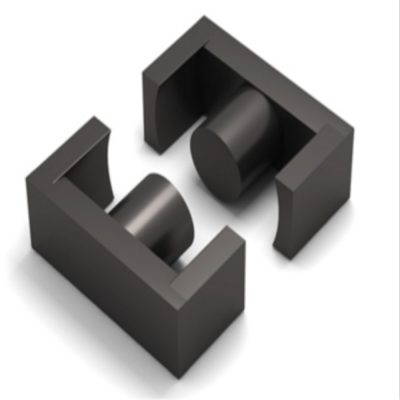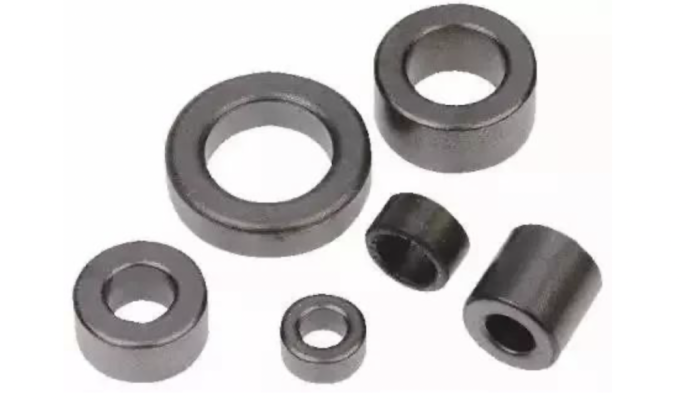A high-frequency transformer is a device that transforms AC voltage, current, and impedance. When an AC current passes through the primary coil, an AC magnetic flux is generated in the iron core (or magnetic core), which induces a voltage (or current) in the secondary coil.
The transformer consists of an iron core (or magnetic core) and a coil. The coil has two or more windings. The winding connected to the power supply is called the primary coil, and the remaining windings are called the secondary coil.
Transformer cores include tank cores, RM cores, E cores, EC, ETD and EER cores, PQ cores, EP cores, EP cores, ring cores, etc. , so how do these cores affect the operation of the transformer? Please see the specific analysis below.
1 Pot core
The bobbins and windings are almost completely wrapped by the magnetic core, so that it has a very good shielding effect on EMI; the size of the pot-shaped magnetic cores conforms to the IEC standard, and the interchangeability is very good during manufacture; simple bobbins (without pins) are available) and PCB mounting frame (with pins). Due to the design of the pot shape, the cost is higher compared with other types of magnetic cores of the same size; because its shape is not conducive to heat dissipation, it is not suitable for high-power transformer inductors.
2 RM core
Compared with the pot type, the two symmetrical sides of the pot type are cut off, which is more conducive to heat dissipation and large-size lead wires; compared with the pot type, it saves about 40% of the installation space; whether there is a skeleton Pin and pin; can be mounted with a pair of clips. The RM type magnetic core can be made into a flat shape (suitable for the current planar transformer or directly assembling the magnetic core on the printed circuit board circuit with the designed winding); although the shielding effect is not as good as the pot type, it is still good.
3 E core
Compared with pot cores, E-type cores are much lower in cost, and combined with simpler winding and assembly, this core shape is now the most widely used, but it has the disadvantage of not providing self-shielding. The E-type magnetic core can be installed in different directions, and several pairs can be superimposed to apply higher power; this kind of magnetic core can be made into a flat shape (it is a very popular magnetic core shape for planar transformers). Needle-free and pin-type bobbins can also be provided; because of their excellent heat dissipation and superimposed use, generally high-power inductors and transformers use this shape of magnetic core.
4 EC, ETD and EER cores
These types of core construction lie between E-type and pot-type. Like E-type magnetic cores, they can provide enough space for large-section lead wires to lead out (suitable for the current trend of low-voltage and high-current switching power supplies). The cores of these shapes also dissipate heat very well; since the central column is cylindrical, the length of the single-turn winding is shortened by 11% compared with a cuboid of the same cross-section, which results in an 11% reduction in copper loss, and at the same time makes the core It can provide a higher output power; at the same time, the central column is cylindrical. Compared with the rectangular parallelepiped central column, it also avoids the hidden danger of damaging the insulation of the winding wire due to the corners of the rectangular parallelepiped during winding.
5 PQ core
PQ cores are specially designed for inductors and transformers used in switching power supplies. The design of the PQ shape optimizes the ratio between the core volume, surface area and winding winding area; this design enables this design to obtain the maximum output power with the minimum transformer volume and weight, and occupy the minimum PCB mounting space. A pair of clips can be used for installation and fixing; this effective design also makes the magnetic circuit cross-sectional area of the magnetic core more uniform, so this magnetic core structure also makes it have fewer working hot spots than other magnetic core structure designs.
6 EP core
The three-dimensional structure of the circular central column of the EP core completely wraps the winding except for the end that is in contact with the PCB board, and the shielding is very good; this unique shape minimizes the contact between the two cores when they are assembled. The effect of the air gap formed by the surface, and provides a larger volume and overall space utilization ratio.
7 simple collocation schemes
For the manufacturer, the toroidal core is the most economical, and its cost is the lowest among the various cores compared with it; due to the use of the bobbin, the additional and assembly costs are equal to zero; when suitable, the winding core can be used the wire machine is wound; its shielding is also very good.







